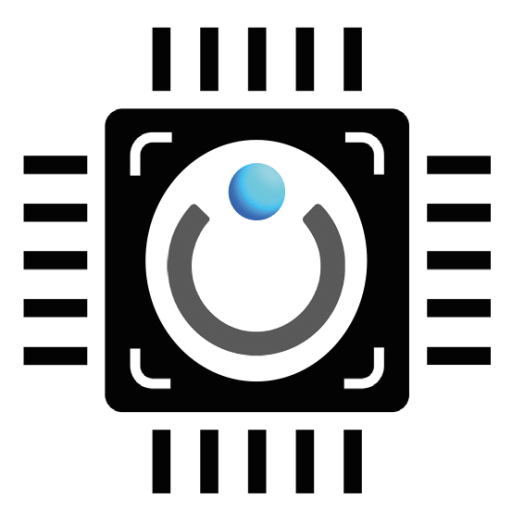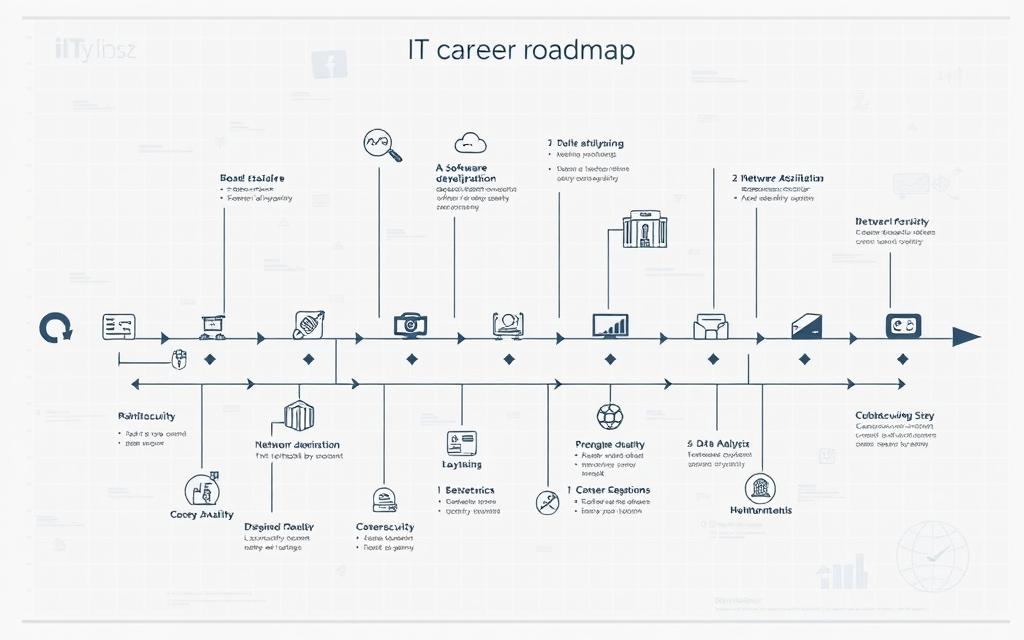The digital world is changing fast, making tech skills development very important for your career. Fields like cybersecurity, cloud computing, and data analytics are in high demand. Experts in these areas have great job opportunities.
In 2024, jobs in these areas will grow by 15-25% in the US, says industry experts.
You don’t need a computer science degree to start a tech career. Many people learn through self-learning IT programs. They get certified by places like CompTIA or AWS.
These certifications show you can do the job and offer a clear learning path. They’re great for those who can’t study full-time.
Starting a tech career can seem daunting, but it’s easier than you think. There are free coding bootcamps, virtual labs, and mentorship programs to help. The most important thing is to pick a specialisation early and get practical experience.
Organisations are moving fast to become more digital. Certified tech professionals are in high demand. By choosing the right certifications and practicing, you can get a job that helps shape the future.
Understanding Information Technology Fundamentals
Starting in IT means learning about its key parts. These are the systems, tools, and processes that make up today’s digital world. Let’s look at the main elements that make up this exciting field.
Defining IT and Its Scope
What Constitutes Information Technology
Information technology is about using computers, managing data, and networking. It’s all about making business operations run smoothly. IT focuses on:
- Creating efficient hardware-software systems
- Securing data transmission channels
- Optimising information storage solutions
Key Sectors: Hardware, Software, Networks, Data Management
The IT world is divided into four main areas:
- Hardware: This includes devices like servers and IoT sensors
- Software: This includes operating systems and apps
- Networks: These are the connections using TCP/IP protocols
- Data Systems: This includes databases and cloud storage
Core Technical Concepts to Master
Computer Architecture Basics
Knowing how parts like CPUs, RAM, and storage work is key for CompTIA A+ certification. Today’s systems use:
- 64-bit processing architectures
- Multi-layer cache hierarchies
- Peripheral connectivity standards
Networking Fundamentals
Every IT pro should know these networking protocols:
| Protocol | Function | Use Case |
|---|---|---|
| HTTP/HTTPS | Web data transfer | Website communication |
| TCP/IP | Data packet routing | Internet connectivity |
| SSH | Secure remote access | Server management |
Data Storage Principles
Modern storage solutions focus on three things:
- Access speed (NVMe vs SATA)
- Capacity needs
- Redundancy protocols
Career Pathways in IT
Entry-Level Positions and Requirements
In the US, common starting jobs are:
- Help Desk Technician (£35k-£45k)
- Network Support Specialist (£40k-£55k)
- Systems Administrator (£45k-£60k)
Most jobs need basic certifications like CompTIA A+ and hands-on IT skills development through projects.
Emerging Specialisations
The IT field is always changing with new areas to focus on:
| Field | Key Skills | Projected Growth |
|---|---|---|
| IoT Security | Device encryption | 32% by 2025 |
| Edge Computing | Latency optimisation | 28% by 2026 |
Building Your IT Foundation
Building a strong technical base needs skill development, quality learning, and hands-on practice. This section shows how to master IT skills. It balances theory with practice.

Essential Technical Skills Development
Start with programming fundamentals. Focus on Python for its use in automation and data analysis. JavaScript is key for web development, and SQL for database management.
Use Codecademy for interactive exercises. It lets you write code in your browser.
Operating Systems Proficiency
Learn to work on different platforms by mastering Linux administration. Practice with terminal commands and shell scripting. Also, learn Windows Server and macOS.
Virtual machines are great for exploring different environments safely.
Cloud Computing Essentials
Begin with AWS or Azure free tiers. Deploy basic virtual machines and storage solutions. Learn about IaaS and use Docker for containerisation.
Google’s IT Support Certificate programme offers practical cloud exercises.
Structured Learning Resources
Use a mix of self-paced courses and formal credentials:
- Coursera Specialisations: University-backed programmes in networking or cybersecurity
- CompTIA CertMaster Labs: Virtual environments for safe infrastructure testing
- edX MicroMasters: Credit-eligible courses from MIT and Harvard
Certification Pathways
Start with vendor-neutral qualifications like CompTIA A+. Then, specialise. The Google IT Support Professional Certificate prepares you for entry-level roles in six months.
Practical Application Strategies
Apply your knowledge with these methods:
- Build a portfolio with projects like Python-based REST APIs
- Contribute to GitHub open-source projects
- Use CertMaster Labs for network troubleshooting drills
Virtual Lab Advantages
Virtual IT labs let you experiment without hardware costs. Set up Azure virtual machines for test websites or security testing. These environments are like real setups but safe.
“Hands-on practice accounts for 73% of skill retention in technical fields according to MIT’s 2023 IT education study.”
Specialising in IT Disciplines
Choosing an IT specialisation is about matching your skills with new technologies. With 72% of US tech firms valuing niche skills (IBM 2024), picking a high-growth area is key. This section looks at three main areas that shape today’s digital workforce.
Software Development Focus
Today’s development roles need expertise in specific tools and teamwork. Let’s dive into some key areas:
Web development frameworks
Frameworks like React and AngularJS are used in 68% of enterprise apps. Developers should focus on:
- Component-based architecture patterns
- Cross-browser compatibility testing
- API integration techniques
Mobile app creation
With 5.3 billion smartphones worldwide, tools like Flutter and SwiftUI are key. Important aspects include:
- Platform-specific UX guidelines
- Offline functionality design
- App store optimisation strategies
DevOps practices
DevOps methodologies cut deployment times by 40% (DORA 2023). Essential tools include:
| Tool Category | Industry Standard | Use Case |
|---|---|---|
| Containerisation | Kubernetes | Microservices management |
| CI/CD | Jenkins | Automated testing pipelines |
| Monitoring | Prometheus | Real-time system analytics |
Cybersecurity Pathways
Cyber threats cost US businesses $4.5 million a year, making security experts in demand. Key areas to focus on are:
Ethical hacking fundamentals
Certifications like CEH v12 prove your skills in penetration testing. Key skills include:
- Vulnerability assessment frameworks
- Social engineering simulations
- Cryptography principles
Network security protocols
Tools like Wireshark help spot 89% of network breaches. Important protocols include:
- TLS 1.3 implementation
- Zero-trust architecture
- DNSSEC validation
Incident response training
CISSP-certified pros earn 38% more than non-certified ones. Key response areas are:
- Threat containment procedures
- Forensic evidence collection
- Post-breach reporting standards
Data Science and Analytics
The US will face a 250,000 data scientist shortage by 2025. Here’s how to meet this need:
Machine learning basics
Scikit-learn and TensorFlow lead in predictive modelling. Key concepts are:
- Supervised vs unsupervised learning
- Feature engineering techniques
- Model validation metrics
Big data tools: Hadoop, Spark
Apache Spark is 100x faster than MapReduce. Its main uses are:
- Real-time stream processing
- Cluster resource management
- ETL pipeline optimisation
Visualisation techniques
Tableau visualisation skills boost hiring by 67%. Best practices are:
| Data Type | Visualisation Tool | Use Case |
|---|---|---|
| Geospatial | Power BI | Sales territory mapping |
| Time-series | Tableau | Financial trend analysis |
| Multivariate | Python Matplotlib | Clinical trial results |
“Bootcamp graduates fill 42% of entry-level data roles, but 78% of leadership positions require advanced degrees”
Developing Professional Competencies
Being good at IT is more than just knowing the tech. You need to work on your skills, get the right certifications, and join tech groups. Let’s see how to boost your career.

Cultivating Workplace Skills
Knowing your tech is great, but you also need skills for the job. Employers want people who can do more than just code.
Technical Documentation Practices
Good documentation is key for IT to work well. Learn to make:
- System architecture diagrams
- API integration guides
- Incident post-mortem reports
Problem-Solving Methodologies
Use methods like the 5 Whys technique and root cause analysis. They help you:
- Find the real problem
- Know what to fix first
- Stop problems before they start
Client Communication Strategies
Make sure you can talk to non-tech people by:
- Explaining things simply
- Using clear charts and dashboards
- Keeping them updated regularly
Certification Roadmap
Certifications show you’re skilled and open doors. Here’s a good order:
CompTIA A+ for Fundamentals
This basic certification covers the basics of hardware, networking, and security. Over 1 million people use it to start their IT careers.
AWS Cloud Architect
This certification shows you know about cloud computing. It covers:
- Designing cloud systems
- How to save money
- Moving to different platforms
Cisco CCNA for Networking
This certification is key for network engineers. It teaches you about:
- IP addresses
- Setting up LANs and WANS
- Basic security
Networking and Community Engagement
Connecting with others helps you grow. It’s a chance to share knowledge and find new opportunities.
Professional Organisations: IEEE, BCS
IEEE membership benefits include:
- Access to the latest research
- Special groups
- Programmes to help you lead
Meetup Groups and Hackathons
Events like DEF CON CTF competitions are great for practice. Local tech meetups offer:
- Workshops on new tools
- Chances to work on projects together
- Insights from the industry
Mentorship Opportunities
Programmes like BCS connect newbies with experts. They help with:
- Planning your career
- Improving your skills
- How to network
Navigating Your Path in the Evolving Tech Landscape
Starting an IT career needs careful planning and being open to change. The field is growing fast, with cybersecurity jobs expected to rise by 32% in the US by 2030. Getting certifications from places like ONLC Training Centres is key to proving your skills and moving up in your career.
Hands-on experience is essential. Sites like GitHub’s Open Source Initiative let you work together and show off your skills. You can focus on areas like software development, data analytics, or network security, making your career path unique.
Keeping up with new skills is vital. Getting recognised certifications like CompTIA Security+, Cisco’s CCNA, or AWS shows you’re serious about your job. Also, improving your soft skills by joining local tech groups or global forums like Stack Overflow can help you make connections.
This guide gives you clear steps to start and succeed in IT. First, get the basics right with certifications. Then, get involved in real projects and join communities that drive new ideas. With hard work and a curious mind, the tech world has many opportunities for you.





